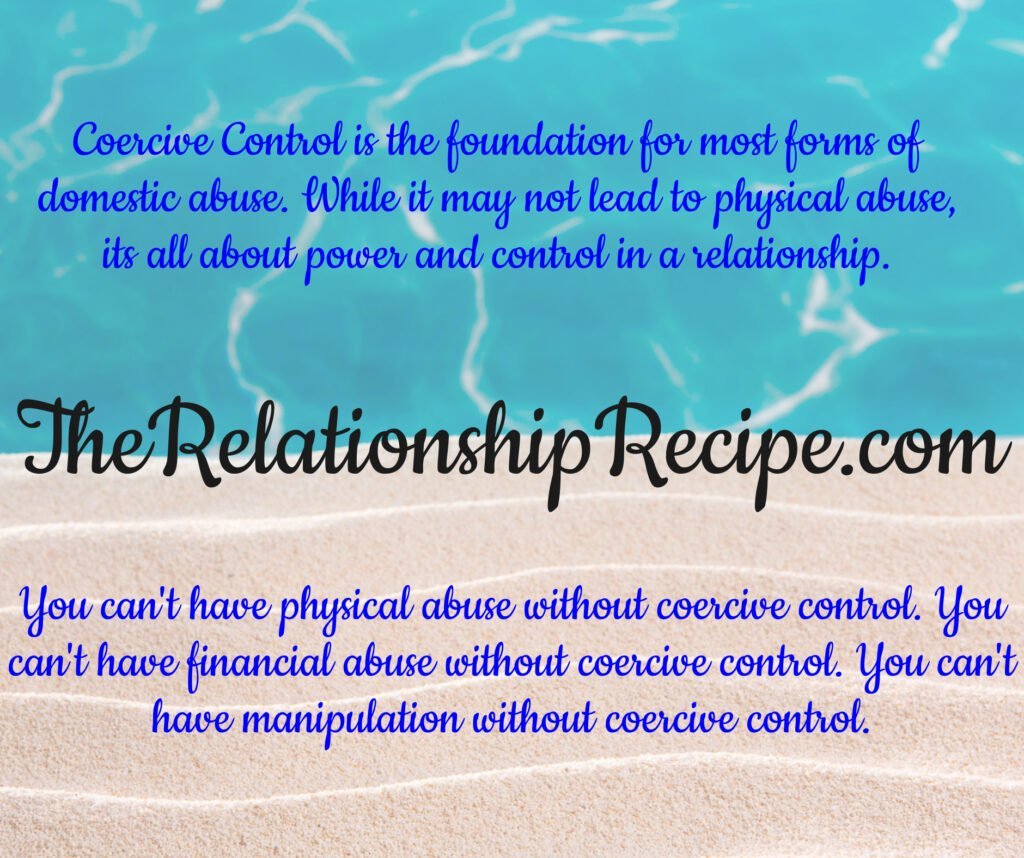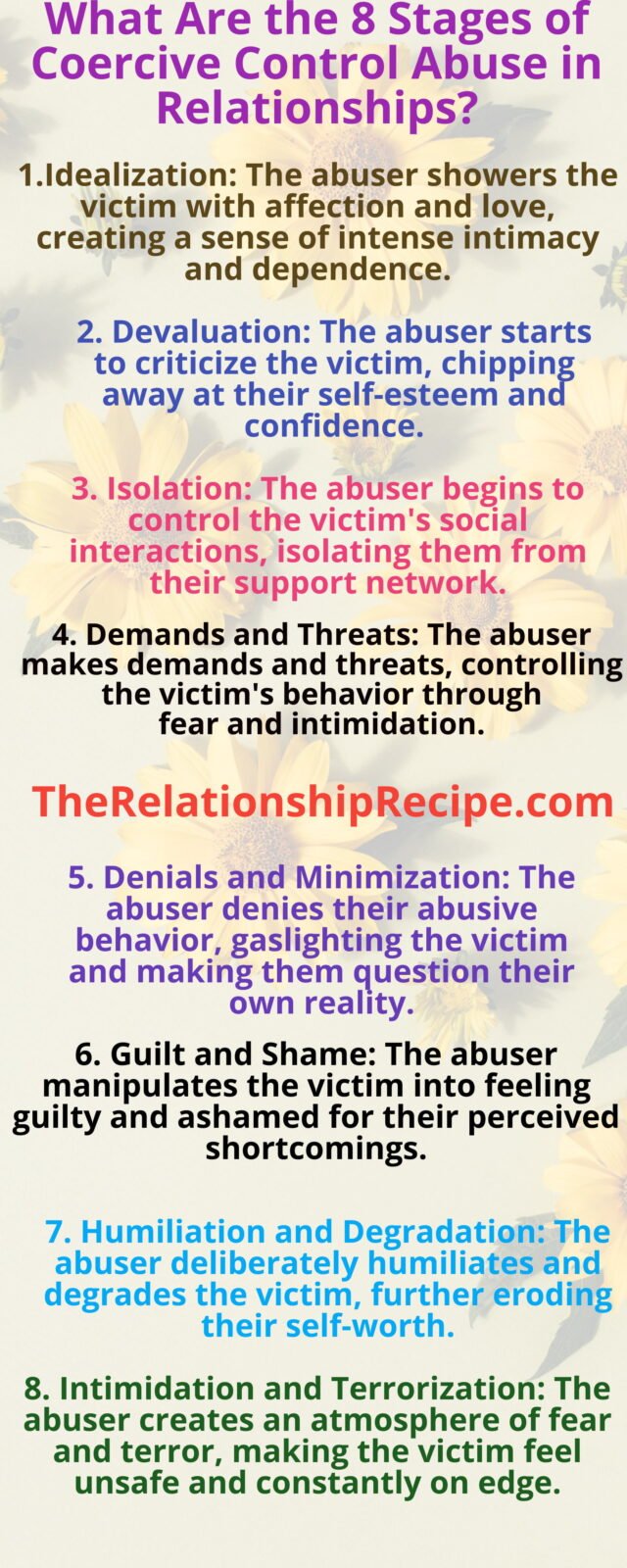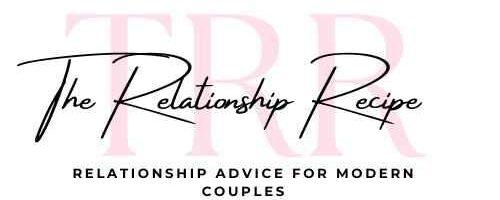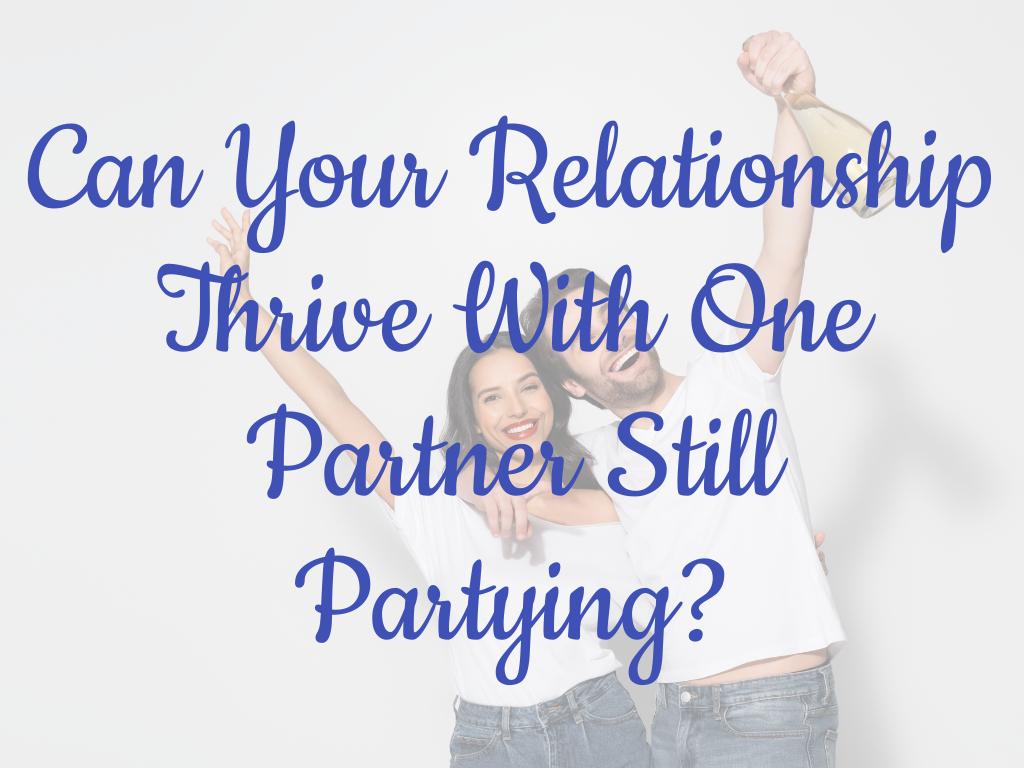Coercive control is a sinister form of abuse that goes beyond physical violence. It’s a calculated pattern of behavior aimed at controlling and manipulating another person, chipping away at their sense of self and identity. This insidious form of abuse can be difficult to identify, often shrouded in a veil of normalcy and love, making it even more devastating for victims.

🚀Coercive Control is the foundation for most forms of domestic abuse. While it may not lead to physical abuse, its all about power and control in a relationship. You can’t have physical abuse without coercive control. You can’t have financial abuse without coercive control. You can’t have manipulation without coercive control.
What are the 3 Types of Coercive Control?
Coercive control encompasses a wide range of tactics, categorized into three main types:
👉Emotional Coercion: This involves manipulation through threats, intimidation, and emotional blackmail. The abuser may make threats of violence, self-harm, or abandonment, or use guilt and shame to manipulate the victim’s behavior.
👉Isolation: The abuser seeks to cut the victim off from their support system, controlling their social interactions and limiting their contact with friends, family, and colleagues. This isolation makes the victim dependent on the abuser and more vulnerable to control.
👉Control: This type involves controlling all aspects of the victim’s life, including their finances, appearance, decisions, and even their thoughts. The abuser may monitor their phone calls, track their movements, and dictate their clothing choices.
What are the 8 Stages of Coercive Control?
Coercive control isn’t instantaneous; it happens gradually, often in eight distinct stages:
1.💡Idealization: The abuser showers the victim with affection and love, creating a sense of intense intimacy and dependence. Also known as “love bombing.”
2. 💡Devaluation: The abuser starts to criticize the victim, chipping away at their self-esteem and confidence.
3. 💡Isolation: The abuser begins to control the victim’s social interactions, isolating them from their support network.
4. 💡Demands and Threats: The abuser makes demands and threats, controlling the victim’s behavior through fear and intimidation.
5. 💡Denials and Minimization: The abuser denies their abusive behavior, gaslighting the victim and making them question their own reality.
6. 💡Guilt and Shame: The abuser manipulates the victim into feeling guilty and ashamed for their perceived shortcomings.
7. 💡Humiliation and Degradation: The abuser deliberately humiliates and degrades the victim, further eroding their self-worth.
8. 💡Intimidation and Terrorization: The abuser creates an atmosphere of fear and terror, making the victim feel unsafe and constantly on edge.

Coercive Control vs. Manipulation: Understanding the Difference
Manipulation and control are often intertwined, but they are not the same. Manipulation involves influencing someone to do something they wouldn’t normally do, often through deception or persuasion.
Coercive control, on the other hand, goes beyond mere influence. It’s about dominating and controlling another person, often through intimidation and fear.
Does the Coercive Controller Know What They Are Doing?
Whether a coercive controller is aware of their actions is a complex question. Some may be fully conscious of their manipulative tactics, while others may engage in these behaviors unconsciously. Regardless of their awareness, the impact on the victim is devastating.
What Personality Type Uses Coercive Control?
There is no single personality type associated with coercive control. However, those with traits like narcissism, psychopathy, and antisocial personality disorder are more likely to exhibit controlling tendencies. Certain personality disorders, like narcissistic personality disorder, are characterized by a need for control and dominance. People with this disorder may exploit others to feel powerful and superior.

Why Men Use Coercive Control in Relationships
While both men and women can be perpetrators of coercive control, research suggests that it is more prevalent in male-on-female relationships. This may be due to factors like traditional gender roles and societal expectations of masculinity. Men tend to use this abuse method because it’s easy to hide behind and it gets them the desired result in a situation.
There are many reasons why a man might use coercive control in a relationship. Some of the most common reasons include:

The Root of the Problem: What Causes Coercive Control?
The causes of coercive control are complex and multifaceted. Possible factors include:
💣Childhood Trauma:
- Experiencing abuse in their own childhood: Individuals who grew up in abusive environments may learn to see controlling behavior as normal and acceptable, leading them to repeat similar patterns in their own relationships.
- Witnessing domestic violence: Witnessing abuse between parents or caregivers can also normalize controlling behavior for children, making them more susceptible to engaging in it themselves later in life.
- Attachment issues: Early childhood experiences can lead to insecure attachment styles, making individuals more likely to seek control and validation in relationships.
💣Personality Traits:
- Narcissism: Individuals with narcissistic personality disorder exhibit an inflated sense of self-importance and a need for control over others. They may use manipulation and coercion to maintain their power and dominance.
- Psychopathy: Psychopathic individuals lack empathy and remorse, making them more likely to exploit and manipulate others without feeling guilt or shame.
- Antisocial Personality Disorder: Individuals with this disorder have a disregard for the rights and feelings of others, making them prone to controlling and manipulative behavior.
💣Social and Cultural Factors:
- Gender roles: Traditional gender roles that emphasize male dominance and female submissiveness may contribute to the prevalence of coercive control in heterosexual relationships.
- Social norms: Societal expectations of masculinity that encourage aggression and control can make it easier for men to justify their abusive behavior.
- Lack of awareness: Limited public awareness about coercive control can make it difficult to identify and address this issue.
💣Additional factors:
- Low self-esteem: Individuals with low self-esteem are more vulnerable to manipulation and control by others.
- Mental health issues: Mental health conditions such as anxiety or depression can make individuals more susceptible to controlling behavior.
- Substance abuse: Substance abuse can impair judgment and increase the risk of impulsive and aggressive behavior, contributing to coercive control.
It’s important to note that these factors are not deterministic. Not everyone who experiences childhood trauma or has certain personality traits will become a coercive controller. However, recognizing these potential contributing factors can help us better understand the root causes of this complex issue and develop more effective prevention and intervention strategies.
💡Here are some additional points to consider:
- Coercive control is not necessarily gender-specific, although it is more commonly observed in male-on-female relationships.
- The impact of childhood trauma can be mitigated through therapy and other forms of support.
- Challenging harmful social and cultural norms is essential for preventing coercive control.
- Increasing public awareness about this issue can empower victims to seek help and hold perpetrators accountable.
By understanding the complex factors that contribute to coercive control, we can work towards a future where everyone can experience healthy and safe relationships.

Subtle Signs of Coercive Control
Coercive control often manifests through seemingly harmless behaviors that can be difficult to identify, especially in the early stages of a relationship. Here are some subtle (and not so subtle) examples:
💣Controlling your time and activities:
- Making constant demands on your time and attention.
- Disapproving of your hobbies and interests.
- Monitoring your phone calls, emails, and social media activity.
- Demanding to know your location at all times.
💣Controlling your finances:
- Taking control of your finances and limiting your access to money.
- Making you ask for permission to spend money.
- Criticizing your spending habits.
💣Controlling your appearance:
- Telling you what you can and cannot wear.
- Criticizing your appearance.
- Making you feel self-conscious about your body.
💣Isolating you from your loved ones:
- Discouraging you from spending time with friends and family.
- Making you feel guilty or ashamed for wanting to socialize.
- Spreading rumors or lies about your loved ones.
💣Constantly criticizing and judging you:
- Putting you down and making you feel worthless.
- Making you feel like you can’t do anything right.
- Using insults and sarcasm to belittle you.
💣Making threats and ultimatums:
- Threatening to harm you or themselves if you leave the relationship.
- Using emotional blackmail to manipulate you.
- Making you feel like you have no choice but to do what they say.
It’s important to remember that these are just a few examples, and the specific tactics used by a coercive controller can vary greatly. If you are experiencing any of these behaviors, it is important to seek help from a trusted friend, family member, or professional counselor.

Is Gaslighting a Form of Coercive Control?
Yes, gaslighting is a form of coercive control. Gaslighting is a manipulative tactic where the abuser deliberately tries to make the victim question their own reality and memories. This can be done through:
- Denying things they said or did.
- Accusing the victim of being forgetful or crazy.
- Shifting blame onto the victim.
- Lying and manipulating the truth.
Gaslighting can have a devastating impact on the victim’s self-esteem and sense of reality. It can make them feel like they are losing their mind and can make it difficult for them to leave the abusive relationship.

Why Do Men Use Coercive Control in Relationships?
Both men and women can be perpetrators of coercive control, but research suggests that it is more prevalent in male-on-female relationships. This may be due to factors like traditional gender roles and societal expectations of masculinity.
Men tend to use this abuse method because it’s easy to hide behind and it gets them the desired result in a situation. While there are many reasons why a man might use coercive control in a relationship, the most common reasons include:
- A desire for power and control.
- Low self-esteem and insecurity.
- A need to feel superior to others.
- Jealousy and possessiveness.
- A history of abuse or violence.
It is important to remember that there is no excuse for coercive control. It is a form of abuse that can have serious consequences for the victim’s physical and mental health.
What Causes a Person to Be Controlling?
The causes of controlling behavior are complex and multifaceted. Some of the possible factors include:
- Childhood trauma: Individuals who experienced abuse or neglect in their own childhood may be more likely to use controlling behavior in their own relationships.
- Mental health issues: Certain mental health conditions, such as narcissism or psychopathy, can make individuals more likely to be controlling and manipulative.
- Social and cultural factors: Societal norms that emphasize male dominance and female submissiveness can contribute to the prevalence of controlling behavior in men.
It is important to note that these are just some of the possible causes of controlling behavior. There is no single explanation for why a person might be controlling.

The Psychological Effects of Coercive Control on the Victim
Coercive control can have a devastating impact on the victim’s mental and emotional well-being. Some of the common psychological effects include:
- Low self-esteem and confidence
- Anxiety and depression
- Post-traumatic stress disorder (PTSD)
- Isolation and loneliness
- Difficulty trusting others
- Self-harm and suicidal thoughts
It is important to remember that the psychological effects of coercive control can vary from person to person. Some victims may experience all of these effects, while others may only experience a few.

How do Abusers React When They Start Losing Control Over Their Victim?
When an abuser starts losing control of their victim, the consequences can be complex and unpredictable. Here’s a breakdown of what might happen:
👉Victim’s Reactions:
- Empowerment and Relief: The victim may feel a sense of empowerment as they break free from the abuser’s control. They may experience increased self-confidence and a renewed sense of self-worth.
- Fear and Anxiety: The victim may also feel fear and anxiety, especially if the abuser has threatened revenge. They may worry about retaliation or further abuse.
- Confusion and Grief: The victim may feel confused and heartbroken, especially if they have been in a long-term relationship with the abuser. They may grieve for the loss of the relationship, even if it was abusive.
- Post-traumatic Stress Disorder (PTSD): Victims of coercive control often suffer from PTSD, which can manifest through symptoms like flashbacks, nightmares, and hypervigilance. This can be exacerbated when the abuser loses control.
👉Abuser’s Reactions:
- Anger and Rage: The abuser may feel angry and enraged as they lose their grip on the victim. They may lash out verbally or physically, or engage in destructive behavior.
- Desperation and Manipulation: The abuser may try to regain control through desperate measures, such as making empty promises, threats, or emotional blackmail.
- Stalking and Harassment: The abuser may stalk or harass the victim, trying to intimidate them and force them back into the relationship.
- Violence: In some cases, the abuser may become violent, especially if they feel threatened or rejected.
👉Seeking Revenge:
The possibility of the abuser seeking revenge depends on several factors, including:
- Their personality: Abusive individuals with traits like narcissism or psychopathy are more likely to seek revenge, motivated by a desire for control and dominance.
- Severity of the abuse: The more severe the abuse, the greater the potential for the abuser to lash out in revenge.
- Victim’s actions: If the victim exposes the abuse or takes legal action against the abuser, it may increase the risk of revenge.
👉Protective measures:
To protect yourself from potential revenge:
- Maintain a safety plan: This should include ways to stay safe from the abuser, such as contacting emergency services, staying in a safe place, and having a support network.
- Seek legal protection: This may involve obtaining a restraining order or filing criminal charges against the abuser.
- Continue therapy: Therapy can help you work through the trauma of the abuse and develop coping mechanisms.
- Stay connected to your support network: Having friends, family, and other supportive individuals around you can provide emotional strength and practical assistance.
Remember, you are not alone in this. There are resources available to help you stay safe and heal from the abuse. If you are concerned about the possibility of revenge, it’s crucial to seek professional help and take necessary precautions to ensure your safety.

Protecting Yourself from a Coercive Controller
If you are in a relationship with a coercive controller, it is important to seek help. Here are some steps you can take to protect yourself:
- Talk to someone you trust about what is happening.
- Create a safety plan.
- Contact a domestic violence hotline or organization.
- Get legal help.
- Seek counseling or therapy.
It is important to remember that you are not alone. There are people who care about you and want to help.
Here are some resources that can help:
- National Domestic Violence Hotline: 1-800-799-SAFE (7233)
- National Sexual Assault Hotline: 1-800-656-HOPE
- The National Coalition Against Domestic Violence (NCADV): https://ncadv.org/
- The Rape, Abuse & Incest National Network (RAINN): https://www.rainn.org/

This post may contain affiliate links. I earn from qualifying Amazon purchases at no extra cost to you.





